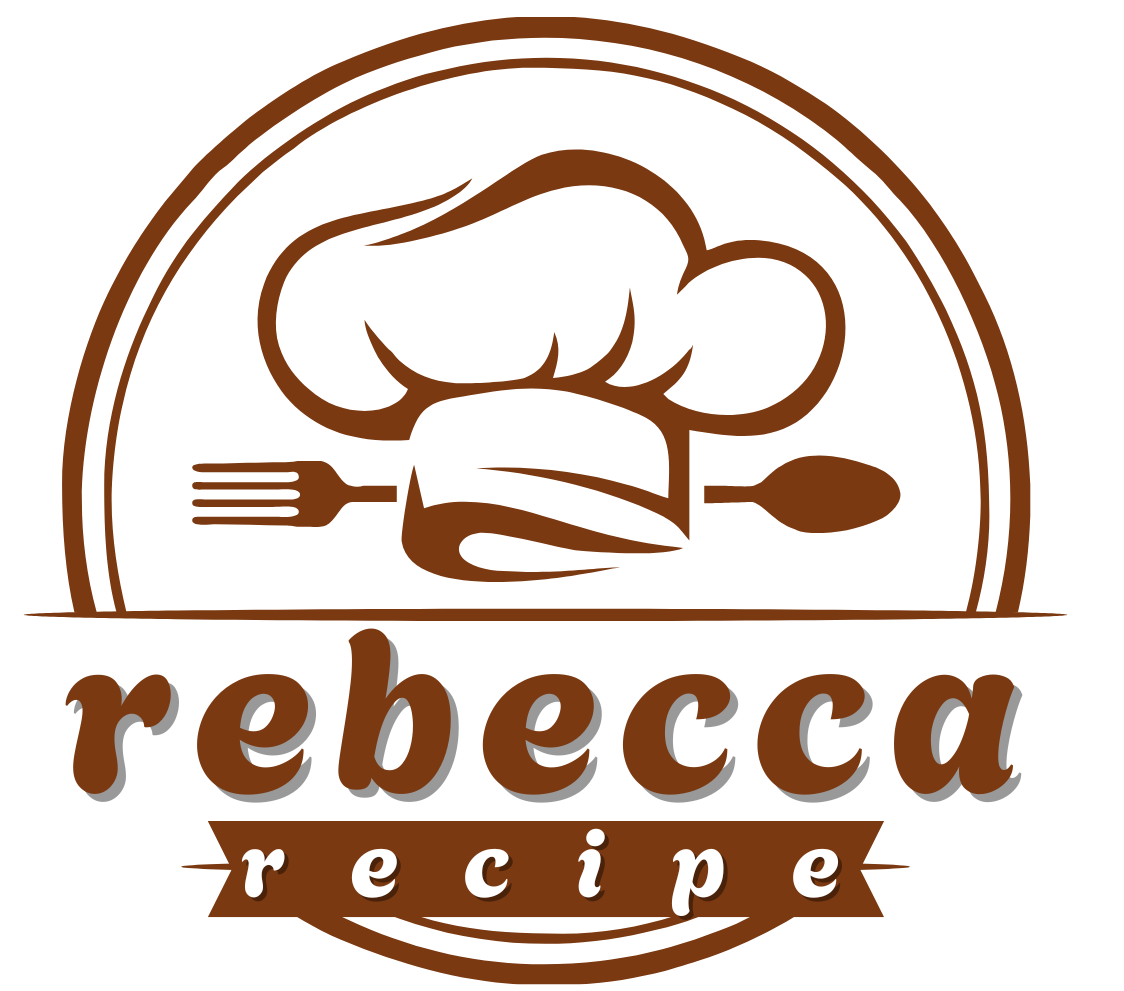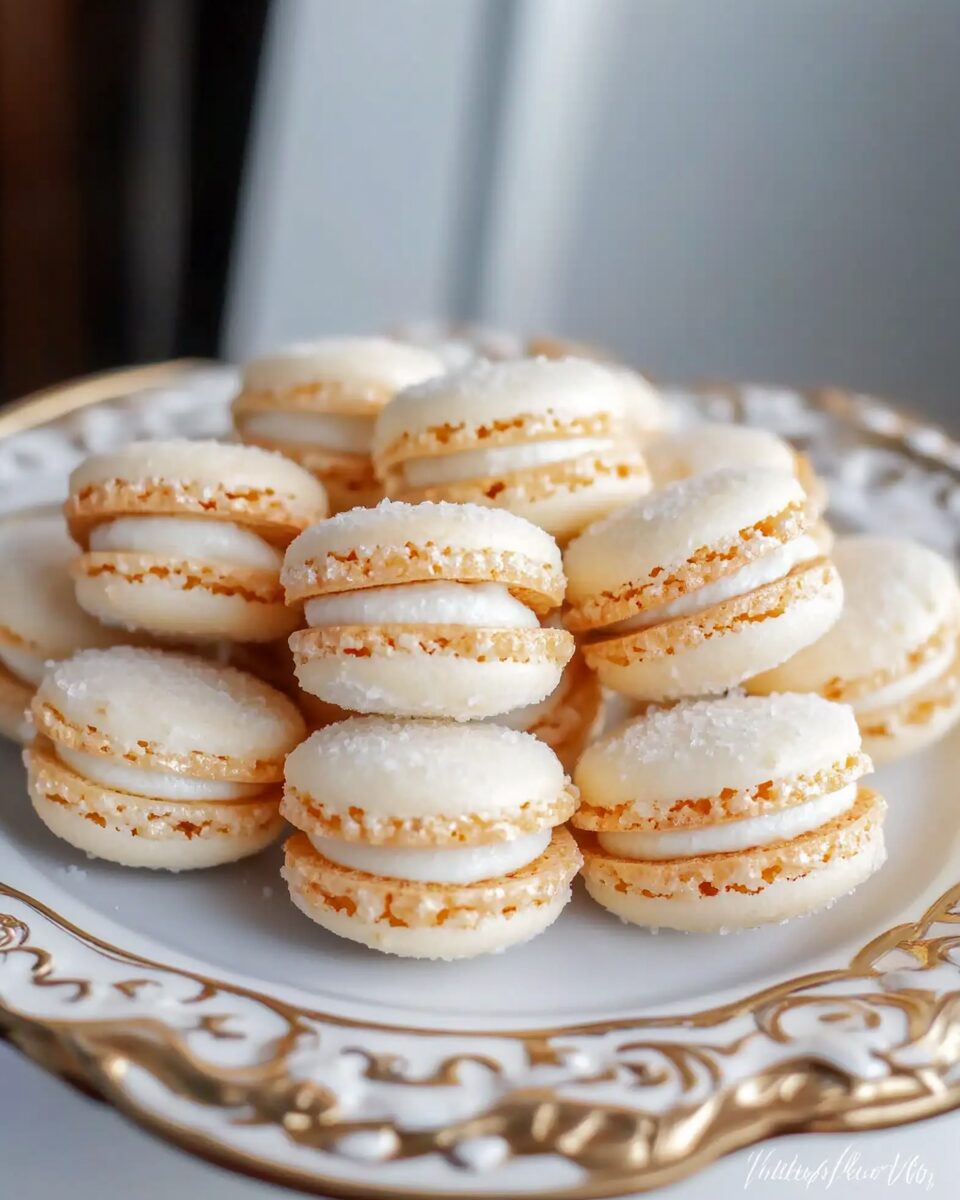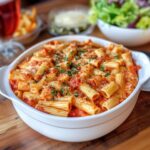Macarons are delicate French pastries known for their smooth, glossy shells and rich, creamy fillings. Despite their sophisticated appearance, with careful preparation and attention to detail, you can create these delightful treats in your own kitchen.
Full Recipe:
Ingredients
For the Macaron Shells:
- 1 cup (96 g) almond flour
- 1 1/2 cups (150 g) powdered sugar
- 3 large egg whites, at room temperature
- 1/4 teaspoon cream of tartar
- 1/2 cup (100 g) granulated sugar
- Gel food coloring (optional)
For the Filling:
- 1/2 cup (115 g) unsalted butter, softened
- 1 cup (120 g) powdered sugar
- 2 tablespoons heavy cream
- 1 teaspoon vanilla extract
- Pinch of salt
Directions
- Prepare the Egg Whites:
- Place egg whites in a clean, dry bowl and cover loosely. Let them sit at room temperature overnight to dehydrate.
- Prepare the Macaron Shells:
- Preheat your oven to 300°F (150°C). Line baking sheets with parchment paper or silicone baking mats.
- Sift together almond flour and powdered sugar into a bowl, discarding any large particles.
- In a clean bowl, beat egg whites and cream of tartar until frothy. Gradually add granulated sugar, beating until stiff peaks form.
- If desired, add gel food coloring and mix until incorporated.
- Gently fold the almond flour mixture into the meringue in three additions until the batter flows like lava.
- Transfer the batter to a piping bag fitted with a round tip. Pipe 1.5-inch (4 cm) rounds onto the prepared baking sheets.
- Tap the baking sheets firmly on the counter to release air bubbles. Let the piped shells sit at room temperature for 40-45 minutes, or until a skin forms and they are no longer tacky to the touch.
- Bake for 12-14 minutes, rotating the sheets halfway through, until the shells have risen and developed “feet.”
- Allow the shells to cool completely on the baking sheets before removing.
- Prepare the Filling:
- Beat softened butter until creamy.
- Gradually add powdered sugar, beating until smooth.
- Add heavy cream, vanilla extract, and a pinch of salt. Beat until fluffy.
- Assemble the Macarons:
- Pair up shells of similar size.
- Pipe a small amount of filling onto the flat side of one shell and sandwich with its pair, pressing gently to spread the filling to the edges.
Nutritional Facts
Per macaron (1 macaron, approximately 1.5-inch in diameter):
- Calories: 100-120 kcal
- Protein: 2 g
- Fat: 6 g
- Saturated Fat: 3 g
- Carbohydrates: 12 g
- Fiber: 0 g
- Sugars: 10 g
- Sodium: 20 mg
- Cholesterol: 15 mg
The History of the Macaron
The macaron’s history dates back to the early 16th century, and while there are many variations of its origin story, one of the most popular versions involves Catherine de Medici, the Italian noblewoman who married Henry II of France. It is said that she introduced the concept of almond meringue-based cookies to France when she moved to Paris. These early cookies were quite different from the macarons we know today, but they laid the foundation for the evolution of the dessert.
Over time, macarons evolved in France. By the 18th century, they had transformed into the lighter, more refined version of the almond meringue cookies we recognize today. The iconic “double-shell” macaron—two cookies sandwiched together with filling—was invented in the early 20th century by Pierre Desfontaines, a Parisian pastry chef, at the famed Ladurée bakery. This innovation made macarons a true symbol of French pastry and quickly became popular around the world.
The Structure of a Macaron
Macarons consist of three main components: the meringue-based shells, the filling, and the smooth texture that brings it all together. The shells are crisp on the outside and soft and chewy on the inside. These contrasts in texture give macarons their signature appeal.
The meringue is made by whipping egg whites with sugar until stiff peaks form. This process is crucial in achieving the signature glossy surface and the feet—those frilly, ruffled edges that form during baking. The addition of almond flour and powdered sugar to the meringue creates the batter for the shells, contributing to the lightness and flavor.
The filling of a macaron is typically made from buttercream, ganache, or fruit preserves. The rich, smooth filling complements the delicate shell, adding flavor and moisture to the dessert. Fillings are often flavored with chocolate, vanilla, pistachio, fruit, or even more exotic flavors like lavender or rose. The possibilities are endless when it comes to customizing the flavor profile of your macarons.
The Science Behind Making Macarons
Making macarons is as much a science as it is an art. Achieving the perfect macaron requires understanding the importance of the meringue, the folding technique, and the temperature of the oven.
The meringue’s structure is critical to the success of the macaron. Egg whites must be beaten to stiff peaks, which means they should hold their shape when the whisk is removed. The sugar added to the egg whites helps stabilize the meringue, while the addition of cream of tartar helps the meringue hold its shape even better. However, over-beating the egg whites can cause them to become too stiff, which will make it harder to incorporate the dry ingredients later on.
The folding technique, known as macaronage, is also crucial. After the meringue is ready, almond flour and powdered sugar are sifted and folded into the meringue. This step needs to be done carefully, as over-folding will cause the batter to become too runny, while under-folding can result in a lumpy, uneven texture. The perfect batter should flow slowly off the spatula in thick ribbons.
Another important factor is the resting period after piping the batter onto the baking sheet. Letting the piped macarons sit at room temperature for 40 to 45 minutes allows the shells to form a skin, which helps them bake evenly and prevents cracking. This resting period is critical to the success of the macaron.
Finally, the oven temperature must be closely monitored. Baking macarons at the right temperature (around 300°F or 150°C) ensures that the cookies rise evenly and develop the characteristic “feet.” Too high of a temperature can cause the macarons to brown too quickly, while too low of a temperature can result in a flat and lifeless texture.
Common Macaron Failures and How to Fix Them
Despite their seemingly simple ingredients, macarons can be notoriously tricky to master. Here are some common macaron problems and their solutions:
-
Cracked Shells: If your macarons crack during baking, it could be due to over-mixing the batter, too much moisture, or an oven that is too hot. Ensure you follow the macaronage technique carefully and allow the shells to rest before baking. If you suspect the oven is too hot, use an oven thermometer to check its temperature.
-
Hollow Macarons: Hollow macarons result when the meringue is over-beaten or the batter is over-mixed. Make sure you stop whipping the egg whites as soon as they reach stiff peaks, and be gentle when folding in the dry ingredients.
-
No Feet: If your macarons fail to form feet, it could be due to under-mixing the batter or inadequate resting time before baking. Be sure to let the piped shells rest until they form a skin, and don’t skip the folding process when making the batter.
-
Lopsided or Uneven Shells: If your macarons are uneven or misshapen, try using a template when piping them onto the baking sheet. A template will help guide the size and shape of each macaron for more uniform results.
Creative Flavor Variations
Macarons are incredibly versatile and can be adapted to suit a wide range of tastes. While classic flavors like chocolate, vanilla, and pistachio are always popular, there are endless opportunities for creative flavor combinations.
-
Fruity Flavors: Fruit-based macarons can be made with fruit jams or purees for the filling. Flavors like raspberry, strawberry, lemon, and passion fruit bring a burst of freshness to the macarons.
-
Chocolate Flavors: Chocolate macarons can feature chocolate ganache or a chocolate-infused buttercream filling. For an extra twist, add fillings like salted caramel or hazelnut spread to complement the chocolate flavor.
-
Nutty Flavors: Almond flour gives macarons a subtle nutty flavor, but you can enhance this by experimenting with fillings like hazelnut buttercream, pistachio paste, or walnut ganache.
-
Exotic Flavors: If you’re feeling adventurous, try making macarons with more exotic ingredients like rosewater, lavender, matcha, or even Earl Grey tea. These flavors pair well with delicate fillings and provide a unique twist on the classic macaron.
How to Serve and Store Macarons
Macarons are best served fresh, but they can be stored for several days. Store your macarons in an airtight container in the refrigerator for up to 3 days. Before serving, allow them to come to room temperature for about 30 minutes to restore their delicate texture.
Macarons also freeze well, and you can freeze them for up to 3 months. To freeze, place the macarons in a single layer on a baking sheet, then transfer them to an airtight container once they are fully frozen. When you’re ready to eat them, let them thaw in the refrigerator before bringing them to room temperature.
Conclusion
Macarons are an extraordinary dessert that requires attention to detail, precision, and patience. The result, however, is well worth the effort. With their crisp, delicate shells and creamy fillings, macarons are sure to impress at any occasion. Whether you’re a novice baker or a seasoned pro, experimenting with different flavors and perfecting the technique will result in beautiful, delicious macarons that will delight your friends and family.






